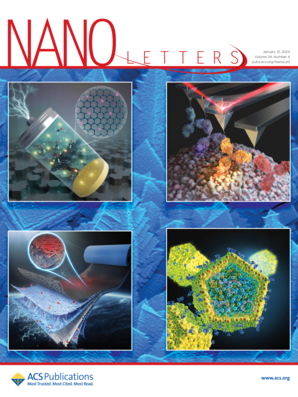Microscopic Kinetics of Water Adsorption in Metal–Organic Frameworks
IF 9.6
1区 材料科学
Q1 CHEMISTRY, MULTIDISCIPLINARY
引用次数: 0
Abstract
Metal–organic frameworks (MOFs) have shown great potential in atmospheric water harvesting, dehumidification, and passive evaporative cooling. Their performance is determined by the water uptake and adsorption kinetics of the MOFs. Here, the water adsorption kinetics in MOFs are systematically investigated using our proposed theoretical framework and experimental measurements. At low relative humidities (RHs), water molecules are adsorbed and diffuse freely in MOFs, as described by the linear driving force assumption and Fick’s law. At high RHs, water condenses into liquid clusters before diffusing, modeled by a two-concentration framework. At medium RHs, both water molecules and clusters coexist in MOFs. Good agreement between experiments and simulations of water uptake and kinetics of UiO-66, CAU-10-H, MOF-801, MIL-101, and MOF-303 demonstrates our theoretical framework fully captures water vapor adsorption processes in MOFs. Our results further show that water adsorption capacity and kinetics are jointly influenced by the porosity, pore radius, and pore geometry factor.

求助全文
约1分钟内获得全文
求助全文
来源期刊

Nano Letters
工程技术-材料科学:综合
CiteScore
16.80
自引率
2.80%
发文量
1182
审稿时长
1.4 months
期刊介绍:
Nano Letters serves as a dynamic platform for promptly disseminating original results in fundamental, applied, and emerging research across all facets of nanoscience and nanotechnology. A pivotal criterion for inclusion within Nano Letters is the convergence of at least two different areas or disciplines, ensuring a rich interdisciplinary scope. The journal is dedicated to fostering exploration in diverse areas, including:
- Experimental and theoretical findings on physical, chemical, and biological phenomena at the nanoscale
- Synthesis, characterization, and processing of organic, inorganic, polymer, and hybrid nanomaterials through physical, chemical, and biological methodologies
- Modeling and simulation of synthetic, assembly, and interaction processes
- Realization of integrated nanostructures and nano-engineered devices exhibiting advanced performance
- Applications of nanoscale materials in living and environmental systems
Nano Letters is committed to advancing and showcasing groundbreaking research that intersects various domains, fostering innovation and collaboration in the ever-evolving field of nanoscience and nanotechnology.
 求助内容:
求助内容: 应助结果提醒方式:
应助结果提醒方式:


